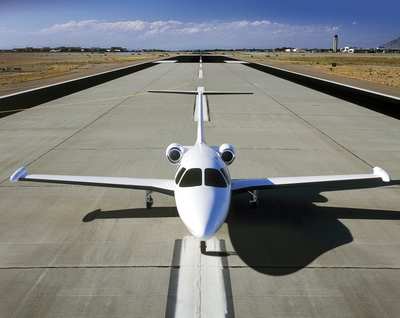But Adds All Fleet Operators Have Already Complied With FAA's
EAD
 Calling the National Transportation
Safety Board's recommendation for immediate checks of throttle
quadrants on Eclipse 500 jets "premature," on Friday Eclipse
Aviation said all fleet operators of the very-light-jet had already
complied with the FAA's Emergency Airworthiness Directive, adding
those planes are in the air and operating normally.
Calling the National Transportation
Safety Board's recommendation for immediate checks of throttle
quadrants on Eclipse 500 jets "premature," on Friday Eclipse
Aviation said all fleet operators of the very-light-jet had already
complied with the FAA's Emergency Airworthiness Directive, adding
those planes are in the air and operating normally.
As ANN reported, that AD was
issued late Thursday, stemming from the circumstances that led to
an emergency landing performed by an Eclipse 500 pilot on June 5,
2008 at Chicago Midway International Airport.
The aircraft, serial number 26, encountered windshear on short
final; when the plane's pilot applied full power, he did so with
enough force against the forward stops to exceed the design
throttle position signal maximum range. The associated fault mode
with the plane's FADEC held the engine thrust settings at the last
known throttle position -- full power.
Following the balked landing, the pilot elected to shutdown one
engine in order to reduce thrust. After spooling down the right
engine, however, the left-side turbofan reduced thrust to idle...
and failed to respond to subsequent throttle inputs. Fortunately,
the pilot was able to perform a safe emergency landing at MDW, with
two blown maingear tires the only damage to plane and crew.
The AD requires a pilot inspection of the thrust quadrant
assembly on each Eclipse 500 in advance of the aircraft's next
flight. The AD does NOT require that any plane in the Eclipse 500
fleet be grounded, the company stressed, adding the checks may be
performed in about 10 minutes. Eclipse has also updated the Eclipse
500’s Aircraft Flight Manual (AFM) and Quick Reference
Handbook (QRH), providing pilot instruction on how to handle a
similar event.
"From this aircraft’s advanced design and development
program, to the rigorous FAA certification process it underwent, to
the exhaustive customer training program we deliver -- the safety
of the Eclipse 500 and well being of our customers is always our
first priority," Eclipse CEO Vern Raburn said. "We are cooperating
fully with the FAA investigation and have communicated everything
we know and have learned about this situation to our Eclipse 500
customers and operators."
In contrast, NTSB chairman Mark Rosenker took the unusual step
Friday of applauding the FAA's fast response in issuing the
Emergency AD, only hours after the Board issued its
recommendations.
"The quick FAA response to the urgent recommendations we issued
could save lives," Rosenker said. "Additionally, the NTSB is
looking forward to reviewing the results of the FAA-required
inspections of these aircraft."

Next week, the FAA and Eclipse will be conducting further
evaluations and tests on the throttle quadrant from the incident
aircraft.
This is the first report of an engine control failure on the
Eclipse 500, and the first incident for an Eclipse 500 in more than
18,000 total fleet hours. Though an early-build aircraft, the
incident EA500 was relatively low-time -- with 238 hours total
time, and 192 cycles.
 Aero-News: Quote of the Day (07.11.25)
Aero-News: Quote of the Day (07.11.25) ANN's Daily Aero-Term (07.11.25): Permanent Echo
ANN's Daily Aero-Term (07.11.25): Permanent Echo ANN's Daily Aero-Linx (07.11.25)
ANN's Daily Aero-Linx (07.11.25) NTSB Final Report: Schweizer SGS 2-33A
NTSB Final Report: Schweizer SGS 2-33A NTSB Prelim: Aeronca 7AC
NTSB Prelim: Aeronca 7AC




